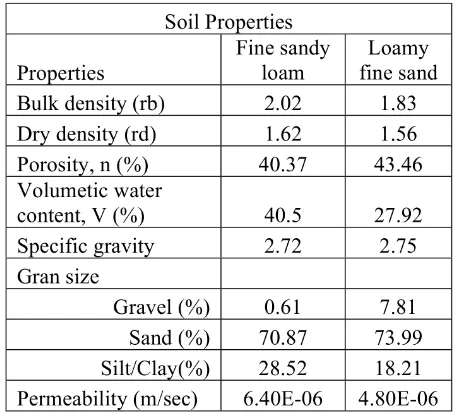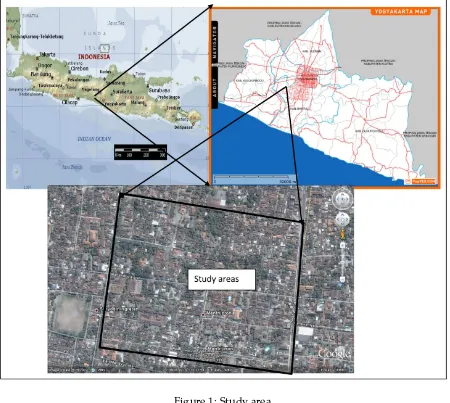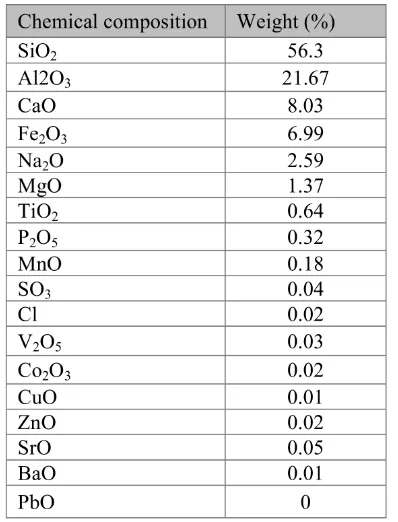COPPER MOBILITY ASSESSMENT USING
SPECIATION SCHEMES: CASE
STUDY–MANTRIJERON DISTRICT,
YOGYAKARTA, INDONESIA
Phetnakhone Xaixongdeth∗1, Heru Hendrayana1, Doni Prakasa Eka Putra1, Dwikorita Karnawati1, and Tsutomu Sato2
1Department of Geological Engineering, Gadjah Mada University, Yogyakarta, Indonesia
2Laboratory of Environmental Geology, Faculty of Engineering, Hokkaido University, Kita 13 Nishi 8, Kita-Ku, Sapporo 060-8628, Japan
Abstract
Heavy metals mobility in soils is controlled by many factors such physical and chemical properties, es-pecially mineralogical composition of such environ-ment. This study focused on the mineralogical of two soils types (fine sandy loam and loamy fine sand) to retain/mobile Cu. Two non contaminated soils from Yogyakarta urban area, Indonesia, were artificially contaminated with Cu solution. Subsequently, soils artificially contaminated were extracted from vari-ous geochemical phases of soil by sequential extrac-tion procedure. The results show that both of soils types can retain Cu well with maximum is 5.8 mg/g of loamy fine sand and 3.9mg/g of fine sandy loam. Additionally, the iron amorphous phase content in clay fraction is influence Cu retains in these soils. This is advantage in environment of Yogyakarta ur-ban area, Indonesia, where this area underlain by loamy sand soil.
Keywords: Copper, mobility, iron, sequential ex-traction.
1 Introduction
Last few decades, environmental effects due to urbanization and industrialization extend very
∗Corresponding author: P. XAIXONGDETH,
Depart-ment of Geological Engineering, Faculty of Engineering, Gadjah Mada University, Jl. Grafika 2 Yogyakarta, 55281, Indonesia. E-mail: [email protected]
fast. Both surface water and groundwater is mainly vulnerable to contaminate from dis-charge of waste-water by various industries, es-pecially in developing countries. Heavy met-als is major contaminant from industry area, which represents a serious problem to envi-ronment due to their great toxicity (Bhagure and Mirgrane, 2001). Since copper is not only widespread toxic metal to environments but also “soft or intermediately soft” toxic metals. Therefore, Cu release and retain to soil much concern. Understanding of copper mobility can provide important information for remediating contamination sites as well as land use plan-ning.
Geochemical process is an important factor control in heavy metal mobile or retain in the soil. The knowledge of how contaminants par-tition among the various geochemical phases allows for better insight into the mechanisms of heavy metals retention and mobile (Cabral and Lefebvre, 1998). In the past, several chemi-cal extraction processes have been investigated for various propose (Gibson and Farmert, 1986;
ANZECC and ARMCANZ, 2000; Plassardet al,
2000; Mullerova et al, 2003; Snape et al, 2004;
Al-Zahrani and Kennichi et al, 2008;
Abdul-Majid, 2009) such as heavy metals retention in soil/heavy production in soil, retention phase.
through the soils which lead to groundwater contamination. The technique of sequential
ex-traction (Tessier et al, 1979 and Kennichi et al,
2008) was employed to assist in the determi-nation of the partitioning of Copper, among of the geochemical phases in fine sandy loam and loamy fine sand, commonly found in urban area of Yogyakarta, Indonesia.
2 Background
Yogyakarta City is situated in Yogyakarta Spe-cial Province, Central Java Island, Indonesia, an educational, a cultural and a tourism city in Indonesia. To its north is Merapi Volcano (peak of the volcano reaches the elevation of
2911 m above sea level, Karnawatiet al, 2006)
and to its south is the Indian Sea. Based on the population census conducted in the year 2004, the population of the city has reached the numbers of 3,257,000 with the growth rate of
0.39%. Population density was 12,206.5/km2at
the city (Karnawatiet al, 2006). The high
pop-ulation growth in Yogyakarta is attributed to the high number of people that migrates into this city every year. Many establishments such as home stays, shopping center, hotels, indus-try and schools had been built. Since the result of population increase, the requests of humans for natural resources also increase which may cause quite serious problems of environmental degradations. One of the most important re-sources in Yogyakarta is shallow groundwater.
Mantrijeron District or the study areas is specifically located in the south part of Yo-gyakarta Special Province with elevation is 90– 100 m above the sea level (Figure 2). The study area mostly covers by batik home industry ar-eas and hotel approximately covering 30 ha.
3 Materials and methods
3.1 Materials
Two soil samples (loamy fine sand and fine sandy loam) were collected from surface depth to water table, at Mantrijeron District, Yo-gyakarta, Indonesia where batik home industry is dominant within this area. Two soil samples are group of sand and loamy with low clay
Table 1: Soil properties of soils at Mantrijeron District, Yogyakart Indonesia.
fraction content. Loamy fine sand were col-lected from a depth of 1.6 m, while fine sandy loam were collected at the same location from a depth of 3.2 m. Soil properties were summary in Table 1. The soil samples were freeze-dried and sieved under 2mm before being stored for
the subsequent experiment. After that, soil
samples were measured mineralogy and chem-ical composition/extractable metals. Mineral phase and mineral chemical composition were identified by X-ray diffraction (XRD) analysis using RINT-2100V/PC diffractometer (Rigaku, Japan), although soil properties of both soils are different but mineralogy is similar (Figure
??). The main mineral of these soil are
anor-thite, albite, and small amount of kaolinite and amorphous iron, while energy dispersive X-ray fluorescence spectrometer, Xepos (Rigaku, Japan) was identified for chemical composition; the major chemical composition of these soil are Si, Al , Ca and Fe which average chemical
com-positions were shown in Table 2. Detection
of high quantity of iron in these soils (Table 2) indicated that iron oxide is an important component of these soils.
3.2 Batch experiments
Figure 1: Study area.
Table 2: Average Chemical Composition of Soil at Mantrijeron Dicstrict.
by Cu solution were perform by batch sorption experiments, 3g freeze-dried soils were added
to 12 mL of CuSO4(2mM) solution in centrifuge
tube and shake for 24 hours, the separation did by centrifuge 3000rpm for 20 minutes and
fil-tered by 0.2µm membrane filter (Figure 3). The
amount of Cu in solution was measured by ICP-AES. freeze-dry. Finally, all soil samples will and stored for sequential extraction.
Figure 3: Batch experiment flow.
3.3 Chemical extraction
All fraction and clay fraction of soil samples were extracted metal in geochemical phases ex-cept the one that bound to silicate by mixing 6M HCl solution (ANZECC and ARMCANZ, 2000
and Snape et al, 2004) with grained dry-freez
soil into ratio 1:1000 of solid:solution at 80◦C for
2 hr. All metals were separated by centrifuge
3000rpm for 20 minutes and filtered by 0.2µm
membrane filter. Finally, Cu concentrations of each step were measured by ICP-AES.
Clay fraction of soil samples were extracted metal that bound to to amorphous, poor crys-talline Iron Aluminum minerals by mixing 0.2M Ammonium oxalete solution (pH 3.0) into ratio 1:600 (solid:solution) at room temperature for 2hr with darkness condition. This extraction
call TAO extraction (Kennichiet al, 2008).
3.4 Sequential extraction
In past decades, sequential extraction was per-formed to strengthen heavy metals bonding onto mineral surfaces in many fields of
re-searches (Tessieret al, 1979; Plassardet al, 2000;
ANZECC and ARMCANZ, 2000; Mullerovaet
al, 2003; Kennichiet al, 2008). In this study,
arti-ficial soil contaminant was prepared by ground to become powder, soil samples (2g) from batch experiments were processed five steps of
ex-traction from Kennichi,et al (2008) (Table 3) to
determine the dominant form of Cu in the soil.
(F1) Water extraction: metal phases soluble
with water. By mixing dieonized water (pH 5.8–6.3) into ratio 1:10, 2g of soil with 20ml of deionized water at room tempera-ture for 6hr.
(F2) MgCl extraction: the residue from (F1)
were added to 1M MgCl2solution (pH 7.0)
into ratio 1:25 (solid:solution) at room tem-perature for 4hr, apportion of exchangeable matals was obtained.
(F3) TAO extraction: the residue from (F2) was added to 0.2M Ammonium oxalete
solution (pH 3.0) into ratio 1:600
to amorphous, poor crystalline iron and aluminum minerals were acquired.
(F4) CDB extraction: metals bound to iron min-erals were obtained by mixing the residue from (F3) with 0.3M Sodium acid citrate, 0.2M Sodium hydrogen carbonate and 0.1g/L Sodium dithionite (pH 8.5) into
ratio 1:100 of solid:solution at 80◦C for 30
min.
(F5) HCl extraction: the residue from (F4) was mixed with 6M HCl into ratio 1:1000 of
solid:solution at 80◦C for 2hr, metals bound
to clay mineral was gained.
In each step, the separation did by centrifuge
3000rpm for 20 minutes and filtered by 0.2µm
membrane filter. Finally, Cu concentrations of each step were measured by ICP-AES. Sum-mary of Sequential extraction steps are shown in Table 3 and Figure 4.
4 Result and Discussion
4.1 Batch experiment
The results of batch experiment show that loamy fine sand and fine sandy loam take up almost 100% of Cu from solution within one hour (99.95% of loamy fine sand; and 99.93%
of fine sandy loam). Based on Xaixongdeth
et al, (2012), the Cu uptake capacity of soil in the study area is correlated to the clay frac-tion, high clay fraction content is observed in loamy fine sand (6.61%) and fine sandy loam (4.69%), while lower clay content characterizes sandy loam (2.78%) and sand (1.89%). maxi-mum Cu sorption capacity in loamy fine sand and fine sandy loam is 5.8mg/g and 3.9mg/g, respectively.
4.2 Chemical extraction
The amount of metals from metals extraction was agreed to XRF result which Al and Fe is main chemical composition in these soil, the summary of the result of metals extraction are shown in Table 4.
In clay fractions, the amounts of Cu that can be extracted from in amorphous iron phase
were similar to amount of Cu that obtained from metals extraction. Loamy fine sand, Cu that detected from metals extraction is 164 mg/kg whereas in amorphous iron phase Cu detection is 175mg/kg. Fine sandy loam, Cu detection in metals extraction is 61.2mg/kg while Cu that detected from in amorphous iron phase is 91.8 mg/kg. Although that Cu from TAO extraction were higher than HCl extrac-tion, the reason could be because of soil samples that was take for both TAO and HCl extraction was dry and grinded in different time which could be give a little different between TAO and HCl extraction. This can be prove that in natural soil of loamy fine sand and fine sandy loam from Mantrajeron, Yogyakarta, Indonesia, Cu sorption to these soil are influence by iron amorphous. Metals bound to clay fraction in loamy fine sand and fine sandy loam are shown in Table 5.
4.3 Sequential extraction
The result of sequential extraction showed that copper sorption to many phases in differ-ent amount. This experimdiffer-ent copper sorption mainly influenced by iron amorphous phase which copper detected in this phase is 86.4% (648 mg/kg) in loamy fine sand and around
65% (492.6 mg/kg) in fine sandy loam. In
F
ig
u
re
4:
E
x
p
er
im
en
t
fl
o
w
o
f
se
q
u
en
ti
al
ex
tr
ac
ti
o
n
Table 3: Selective extraction scheme: (Tessier and Campbell 1988, Plassardet al, 2000 and Kennichi
et al, 2008).
Table 4: Summary of metals extraction in mg per kg of soil.
Figure 5: Distribution of Cu in soil after batch experiment with extraction phases.
5 Conclusion
Loamy fine sand and fine sandy loam from ur-ban area at Mantrijeron, Yogyakarta, Indone-sia, are good for Cu sorption (low mobility) with maximum Cu sorption capacity in loamy fine sand and fine sandy loam is 5.8mg/g and 3.9mg/g, respectively. Cu distribution in both soil were many phases in different amount. Se-quential extractions strong agree to the result from chemical extraction, which Cu distribu-tion influenced by amorphous iron in clay frac-tion.
According to result of chemical extraction and sequential extraction, can be concluding that iron amorphous in clay fraction was influ-enced for Cu sorption (mobility) in these soil. This is advantage in environment of Yogyakarta urban area, Indonesia, where this area under-lain by loamy sand soil amorphous were influ-enced for Cu sorption in this study area.
Acknowledgment
Authors would like to thank the ASEAN University Network Southeast Asia
Engi-neering Education Development Network
(AUN/SEED-Net) program under the Japanese International Cooperation Agency contribution (JICA) and Center for Engineering Education Development (CEED), Hokkaido University for financial support academic contribution to this research. Authors also have a deep of appre-ciation to Agriculture Center Yokohama Plant Protection Station, The Ministry of Agricul-ture, Forestry and Fisheries of Japan 231-0003 that gave authors a permission to bring soil to Japan. Last but not least, special thanks go to Mr. Toru Nishiuchi who gave great assisted to this research.
References
Al-Zahrani, A. A., and Abdul-Majid, M. H. (2009) Extraction of Alumina from Local Clays by Hy-drochloric Acid Process. Eng. Sci. 20: 29–41. ANZECC and ARMCANZ (2000) Australian and
New Zealand Guidelines for Fresh Water and Marine Water Quality. Australian and New Zealand Environment and Conservation Coun-cil/Agriculture and Resource Management Council of Australia and New Zealand, Can-berra.
Bhagure, G. R., and Mirgane, S. R. (2011) Heavy Metal Concentrations in Groundwaters and Soils of Thane Region of Maharashtra, India, Environ Monit Assess 173: 643–652.
Cabral, A. R. and Lefebvre, G. (1998) Use of Sequen-tial Extraction in The Study of Heavy Metal Re-tention by Silty Soils. Water, Air, and Soil Pollu-tion 102: 329–344.
Flores-Rodriguez, J., Bussy, A. L., and Thevenot, D. R. (1994) Toxic Metals in Urban Runoff: Physico-Chemical Mobility Assessment Using Speciation Schemes, Wat. Sci. Tech. 29: 83–93
Gibson, M. J., and Farmert, J. G. (1986) Multi-step Sequential Chemical Extraction of Heavy Metals from Urban Soils. Environmental Pollution (Se-ries B) 11: 117–135.
Mullerova, H., Kruml, O., Vybihal, K., Zeman, J., and Muller, P. (2003) Adsorption of Copper and Cadmium from Aqueous Types of Sediments un-der Static and Dynamic Conditions. Bulletin of Geosciences 78: 169–178.
Plassard, F., Winiarski, Th., and Petit-Ramel, M. (2000) Retention and Distribution of Three Heavy Metals in a Carbonated Soil: Comparison be-tween Batch and Unsaturated Column Studied, Journal of Contamianant Hydrology 42: 99–111. Snape, I., Scouller, R. C., Stark, S. C., Stark, J., Riddle,
M. J., and Gore, D. B. (2004) Characterisation of the Dilute HCl Extraction Method for the
Identi-fication of Metal Contamination in Antarctic Ma-rine Sediments. Chemosphere 57: 491-504. Tessier, A., Campbell, P. G. C., and Bisson, M. (1979)
Sequential Extraction Procedure for the Specia-tion of Particulate Trace Metals. Analytical Chem-istry 51: 844–851.





